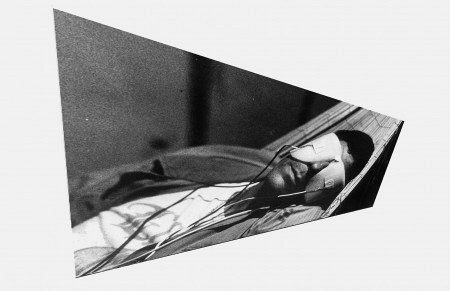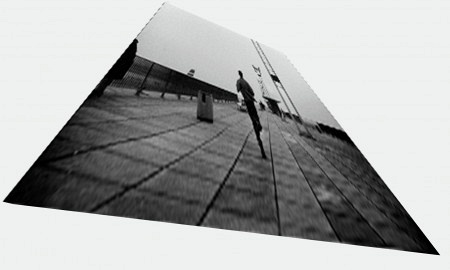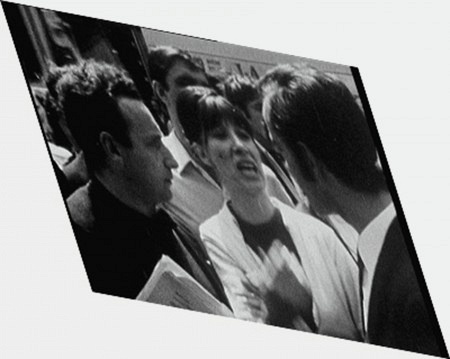Dead the ends and colour war for now so if you see a brother… SALUT! if you see a fed… SHOOT!
—Anonymous Blackberry message, London riots, 13 August 2011.
The year is 2040. Facing species extinction and environmental collapse, the members of the Central Control Committee (CCC) of the newly established World Commune resolve to deploy their last hope—the time machine.
The CCC’s director breaks it down for his comrades: unknown to most of the population, the machine has been operational since at least 1971. The machine was not planned as such. In fact, they had been trying to construct a kind of huge printer. The idea was to fix the US current account deficit by printing money. Facing profits crisis, the government delinked the dollar from gold. At a stroke, the global currency ceased to be backed by a metallic commodity indexing real value, human labor. Instead the world currency was now built on debt. An endless supply of ‘fictitious capital’—mere paper claims on potential future value—came to life. It worked pretty nicely for several decades, effectively deferring the crisis. But the printer had one unintended side effect—the director pauses to allow the room to fill with silence—the destruction of linear time.
No, he explains, the printer was not just a printer. The powers that be had accidentally created a time machine. It scrambled temporal sequence and unleashed a recombinant, recursive culture as frenetic as it was immune to radical change. Just as labor was growing increasingly superfluous to production, the time machine imposed massive quantities of work on the human population, exponentially increasing stress on the physical infrastructure of the planet.
At first the time machine seemed to stall and reshuffle history like a deck of floating signs. But eventually we began to see that the legend of a synchronic, self-renewing system concealed real social and material retrogression. Not acceleration but cannibalization was the true product of the time machine.
The director is somber. With no way out of a global environmental crisis, he declares, we must turn the machine against itself. We will use it to prevent its own inception, simultaneously unleashing the revolution that it baulked.
But this project would require an agent of an almost extinct breed: a proletarian. The CCC selects a survivor of the world war that preceded the global insurrection in which it came to power. A man tied to the past by his obsession with an image, a powerful childhood memory of tenderness and loss.
The violent scene that marked him happened at Heathrow Airport in London, 2007. The man’s mother had taken him along on a demonstration against climate change. There, in the terminal’s departures hall, among the cops and protestors, he had seen a man get shot and die in the arms of a woman. Had he really seen it or just invented it, a fictitious claim against the madness to come? It was unclear, but if he could conceive or dream of the time before the war, perhaps he could live in it.
The director explains the man’s historic task. The time machine is a vast distributed computer whose ‘hardware’ is constituted of social relations as much as material things. The fashion system and the finance system would each function as core components. They will use the machine to send him back to delete its preconditions, effectively undoing their own tranche of time, saving the species and the world.
1. Mission 1: Destroy the Retro-Structure
The man is sent to London in the year 1971. His mission: infiltrate a revolutionary libertarian group and persuade them to blow up a fashion boutique called Biba. The man wins the trust of a young woman in the group and delivers a fierce critique of the decadent new temporal and economic logic of which Biba is a beacon. The new retro culture is just a reworking of the past. “In fashion as in everything else, capitalism can only go backward—they’ve nowhere to go, they’re dead. The future is ours.”
The group dig his analysis, and agree to an assault against Biba’s flagship store in London’s then-swinging Kensington. The mission more or less succeeds, with no serious injuries. Yet their May Day bomb fails to spark the revolt against the new kind of new—the emergent temporal loop of recycling and remixing and empty reflexivity—that the CCC had hoped for. Instead, the bomb confirms the ascendancy of the hip new entrepreneurs, merchants of non-linear time. From here on revolution gives way to involution. Raiding the past, looting the present, foreclosing the future.
During his trip, the CCC’s agent falls in love with the young woman revolutionary. He comes and goes, flitting in and out of her life—she calls him her ghost. After the bomb, the man disappears for good. A short while later the woman realizes she is pregnant with his child. She names the boy after him—John Marker, the name given to the agent by the CCC. At four years of age, the boy falls ill and dies. Yet, as the Central Control Committee discovered back in 2040, the child lived on. Twenty years later, the police had appropriated and recycled his name and birth date to furnish the cover identity, known in the trade as the legend, for an undercover cop infiltrating the UK anti-globalization movement. Even the dead were not safe from the time machine.
2. The Future of a Delusion
The CCC sends the man back on a second trip through time—not into the future, but rather to a future that once was, that might have been. Once again he travels back to the spring of 1971, but this time to the TWA Flight Center at New York’s JFK Airport, a space-age marvel. Here the man is to meet and pass a dossier to the young foreign aid economist, Michael Hudson. It explains that the dollar’s convertibility against gold is set to end in August 1971, unleashing an era of epic US monetary super-imperialism. If the dollar is taken off the gold standard, far from collapsing, it will float free. Raising world money to a new power of abstraction will not mark the end of the US as global hegemon. Rather, it will unleash a potentially unlimited regime of extractive accumulation based on the economic tribute the US can claim from the rest of the world via the system of international loans. The US’s decline as a producer and its bankruptcy as the world’s number one debtor will bring about a tendency among its creditors—including the rising new capitalist powers in the East—to recycle their wealth into US treasuries. What else could they do, given that America remains the number one customer for their goods and the dollar the global reserve currency? Effectively, if no one sounded the alarm, the US was about to begin a decades-long ‘free lunch’ at the expense of the world’s rising producers, not to mention the devastation of the planet this looting process will accelerate.
The man, woozy with time sickness and pining for his lost love, fails to locate Hudson in the terminal. However, he does run into the woman. She is en route to the West Coast, fleeing police repression in the UK. He tries to explain where he has been and what he was doing and begins a patchy but animated account of the CCC’s analysis. By a quirk of the Flight Center’s fluid architecture, Hudson finds himself next to them as he waits for his flight to Washington. The economist slowly grasps that the young man talking to the woman opposite him has convincingly identified a way for the US to turn its profits crisis into a mechanism for indefinite economic hegemony. He resolves to follow-up the hypothesis and publish an indictment of the new system before this young radical beats him to it. His book will only sell moderately well but it is bought and read closely by agents of the US government. Its hypothesis is spot on and they decide to make the most of the strategy the state has accidentally hit upon and to implement this new monetary super-imperialism on an expanded scale.
Back in the future, the members of the CCC, depressed to find themselves still in existence, quickly realize their plan has failed again. In fact, their very intervention has made the present disaster inevitable. Renouncing their attempts to defeat the time machine with propaganda by the deed or policy changes, they resolve to follow the Marxian hypothesis that deeds are themselves the source of ideas. They will attempt to redirect the anti-capitalist movement the time machine itself gave rise to. The Left have been part of the time machine just as much as finance and culture, and they were seeking to turn the clock back, to challenge ‘consumerism’ and the excesses of “the one percent” rather than tackling capitalism head-on. A moral critique of bankers and parasites and bloated ‘materialism’ easily segued into the rise of racist, anti-Semitic, and quasi-fascist forces as the austerity years drew on. At worst, the Left were one more non-reproduction of old agendas and ideologies, one more recycled set of second-order signs and zombie socialism, with a sacrificial narrative of their own. The man finds the CCC’s arguments prolix but assents to a third trip, optimistic he will meet the woman again. Perhaps this time he will find a way to remain with her.
3. Workers Leaving the Factory
True to their renewed materialist principles, the members of the CCC send their agent back to 2008, to the time of the workers’ occupation of the Ford Visteon factory in Enfield, north London. The man urges activists en route to the G20 protests in the City financial district to join the workers’ struggle, but they dismiss him. They are not into cars, one explains, the environment is more important than some doomed old industrial jobs. The man then begs the Visteon workers to maintain their occupation in the face of a Trotskyist group’s advice to declare a victory and give it up. The group’s activists insinuate that he is a cop or an agent of the bosses. One of the activists, who goes by the name John Marker, denounces him and his comrades hound the man out of the occupation.
Outside the factory gates a woman, one of the comrades in the Trotskyist group, runs toward him. She is young, just a supporter. But the man has seen her on the picket line, talking to the man who denounced him. Has he seen her before? Is it her hair, something about her retro style, or do all women now seem to him like citations of the woman of his memory? He isn’t sure, but he listens as she whispers frightened and angry words.
…a member of the CC—the Central Committee…a hotel bedroom…forced…not just once…six months now…I told John…we can’t go to the police, he said…for the party, for the cause…
The man sees there are tears running down her cheeks. Time washes over him like a wave and he is back in the future.
Once again the CCC has to reckon with failure. Exhausted and broken, the man is informed that he must make one last journey. By means of a foiled assassination attempt on a cop infiltrator of the anti-capitalist milieu, the CCC will place him at the head of a new movement against austerity. From prison he will expose police and state surveillance of activists and the wider population, building a fully revolutionary struggle. The CCC will keep in continuous contact with the man. Success will take time and there will be no return for the man, but his success will make reformism and its disastrous future as impossible as capitalism.
The man has other ideas. He yearns for the moments without plan or purpose that he spent with the woman. His mind fills with thoughts of her face, her gestures, the time that was briefly theirs.
4. Terminal Swerve
Thrown back into the past, the man discovers himself at Heathrow Airport, in the summer of 2007. He realizes that the child he had once been must be there too, watching the planes, on his way to the Climate Camp with his mother. He looked for the woman’s face amid the protestors and police in the departures hall. But when he sees the cop—the infiltrator that the CCC has sent him to kill—he realizes that no one can escape the time machine. This haunted moment, the scene he had witnessed as a child, would be the moment of his own death.
He looks down and sees the pistol the CCC has given him. Watching the woman activist he had already met later, in Enfield in 2008, as she runs toward the cop—the counterfeit activist who has infiltrated her political scene—he doubles down with déjà vu. Her face merges with that of the woman he loves. She calls out the cop-activist’s name—the same name the CCC has given the man himself, the name that, unbeknownst to him, the woman gave their child. He is seized by vertigo.
Where does this name come from? Is he himself not just one more clone of a stolen name, one more replicant identity generated by the time machine? He will rewrite the CCC’s plan and cut through the möbius loop of time, avenging all the betrayals, the betrayal he himself is. He raises and fires the weapon.
As the bullet passes through the forehead of the counterfeit protestor, the man feels time dilate. Some hitch in the cycling of the time machine, or the impact of his act—wasn’t his bullet meant to be a blank? Isn’t his own presence in the moment some kind of temporal knot or recursive loop?—causes a glitch in the temporal sequence.
The man—or one version of him—is flung out of the moment. He begins to slide across time and space, swerving like a stylus knocked out of the groove of an old record (or a new, 180-gram one). Like some errant atom, he flies by, tracing a circuitous vicus of recirculation from South London in 2007, past his future past at the occupied factory in Enfield in 2008, and on to Tottenham, North London, where he reappears at 6:13 p.m. on the evening of the fourth day of August 2011.
5. Mission Without End(s)
A few hundred yards from the retail park at Tottenham Hale, a convoy of police cars is chasing a minicab on the highway. In the back of the car sits Mark Duggan, a young black man in his late twenties. He is suspected of planning a crime. His pursuers are about to commit one.
Back in the future, the CCC members scan the timeline, a tangled mess. There’s nothing there, nothing significant in August 2011. Duggan’s name doesn’t show on their screens. Scrolling back a little, images of a failed movement against education cuts and fee increases, then nothing till Occupy, a ripple rapidly decaying into a movement for monetary reform, years of defeat, the rising tide of racism and anti-Semitism, the campaign against the Octopus of the banks, the invasion of immigrants, a rapid slide down the graph of retrogression…
The cops force the car to a halt, hemming it in with their vehicles. Hard stop. Duggan jumps out of the car and begins to run, but one of the cops is there with his submachine gun poised to shoot. Duggan freezes, raises his hands above his head. But the cop is wired—young black male possibly armed… he knows whose side the law is on.
Just as he is about to shoot, the man appears in front of the cop. The cop freezes for a moment. It’s totally weird, this unaccountable apparition. And then his training, or his reflexes, it’s impossible to distinguish, kick back in. He squeezes the trigger. But the man is already in motion. The bullet misses him, goes through Duggan’s arm, grazes another cop and buries itself in his police radio.
The members of the CCC huddle over the data screens, rapt as a new sequence of events begins to crystallize in the archive.
The cop twitches and adjusts his aim within a few milliseconds. It won’t be enough just to stop the black man, he has to erase the other, the freak apparition who so unsettles him. He pulls the trigger but again the stranger is too quick for him, more non-linear than cop time itself. He fires the semi-automatic but the bullet goes right past the man and hits Duggan in the chest. A few thousand milliseconds later, the young black male is dead.
The CCC members watch the timeline, scry the fossilized Twitter feeds as their characters scatter into new distributions. The name Duggan flashes up on their screens. The SMS messages from a hitherto absent future begin to proliferate. Something is coming to birth… and suddenly the CCC members are seized by the intuition that this young black man’s death has something to do with their own existence, their realization or abolition…. The databases begin to fill with information just as the CCC’s present moment itself begins to tremble…Mark Duggan…murdered by police…triggering the riots of 2011…first insurrection of the superfluous majority, first intimation of a new global movement…The members of the CCC look up from their screens…
The cop moves to aim his weapon a third time, searching for the man who appeared in his gunsight like a chip of shattered time. But where he had been the cop sees only blank space. The man had vanished—cancelled like an empty sign, written off like a bad debt, gone.
Within a few hours, news of Duggan’s murder trickles out. As the police respond brutally to peaceful protests, the riots begin in Tottenham, rapidly spreading throughout the city and across the UK. The gangs declare a truce between the ends—the poor neighborhoods divided within and against each other by race and gender and geography. The uprising begins.
Everyone from all sides of London meet up at the heart of London (central) OXFORD CIRCUS!!, Bare SHOPS are gonna get smashed up so come get some (free stuff!!!) fuck the feds we will send them back with OUR riot! >:O Dead the ends and colour war for now so if you see a brother… SALUT! if you see a fed… SHOOT!
—Anonymous Blackberry message, London riots, 13 August 2011.
END
A longer version of this text was originally written for the following upcoming publication (2015) and will be included in it in a longer version: The memory of it sometimes comes to you in the bright light of the beach, through the transparency of the rolling waves - Encircling the Image of Trauma, pub. Centre d’Art Contemporain Genève/Archive Books. With contributions by Andrea Bellu, Anca Benera & Arnold Estefan, Pavel Büchler, Aurélien Gamboni, Katja Mater, Wendelien Van Oldenborgh, Georges Perec, Falke Pisano, Natascha Sadr Haghighian, Benedict Seymour, Gitte Villesen, Unica Zürn; ed. Matei Bellu and Emilie Bujès.
The author would like to declare a (collateralized) debt to Chris Marker’s La Jetée.



